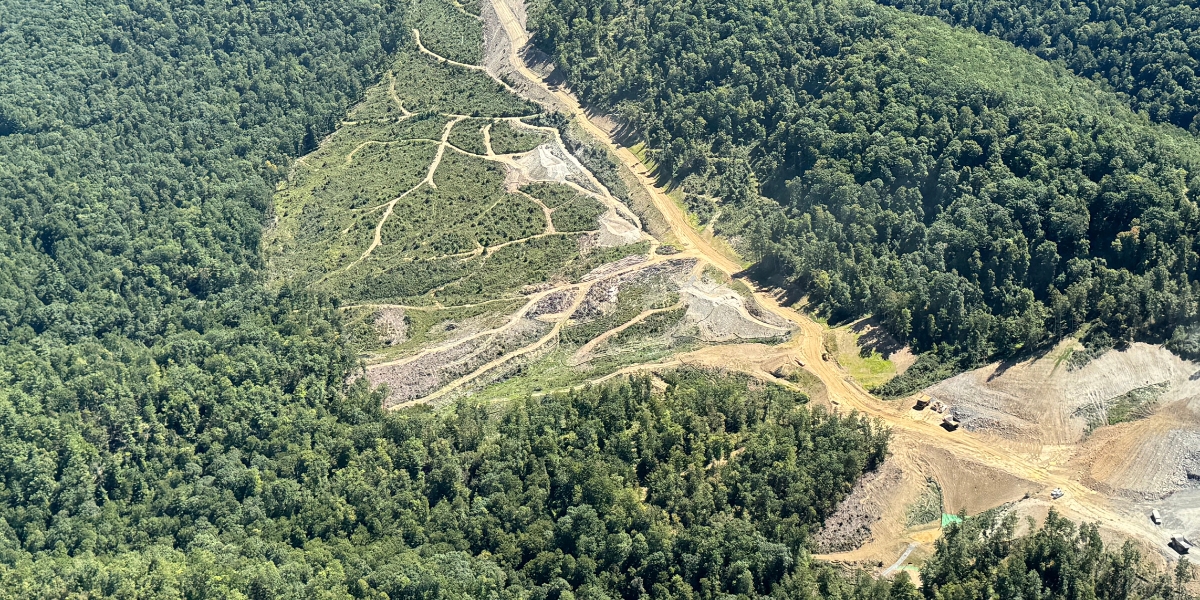From the Go North Corridor H Alliance
The computer-generated simulated photos that WVDOH brings to our local information meetings and that appear on their website show a finished highway spiraling through the mountains, crossing high bridges … and lined with fully grown trees. WVDOH does not bring actual photos of the construction phase of the project—a phase that can last for years, a phase that turns the landscape into a moonscape and causes confusion, delays, and devastation.
Those of us who drive from Thomas, WV to Elkins, WV on US Route 219 are familiar with the construction phase of Corridor H. We’ve experienced the closures and delays and have seen the devastated landscape. Documenting some of what we have seen is not to place blame, but to open up the discussion of what is really coming and discuss the potential impact of the construction phase on our quality of life, our tourism economy, and our livelihoods.
On the Elkins to Kerens section, we have watched a 1.5-year closure of a bridge to correct faulty abutment design and reconstruction at Leading Creek in Randolph.
At Moore in Tucker County, the bridge has been under construction for seven years, closing one of our popular tourist destinations, the Allegheny Highlands Rail Trail between Montrose and Moore, for seven years, disrupting bicycle, pedestrian, and horseback travel between Parsons and Elkins.
Recently, on level ground in Holly Meadows near Parsons, a crane raising a large steel beam failed, and the beam crashed to the ground. Luckily, no one was hurt. The accident is under OSHA investigation; there will be unknown cost increases in checking the integrity and/or replacement of the dropped beam and unknown construction delays.
During construction of the Kerens to Parsons section of Corridor H between 2017 and 2022, 51 violations have been issued based on 336 reported instances of non-compliance with sedimentation issues. The next section of Corridor H to be built is from Mackeyville to Davis. Everyone involved will agree that this section has the steepest terrain, is the most difficult to construct, and is the most environmentally sensitive. Given the number of trout streams in this segment, and the steepness of the terrain, more violations and direct impact on the Cheat River can be anticipated.
On WVDOH’s “preferred route,” the ROPA, another high bridge over the North Fork of the Blackwater River between Coketon and Douglas is proposed. This construction will cross the Blackwater Canyon Rail Trail, the most popular trail in the region, used by thousands of visitors every year and worth millions in revenue to Thomas and Parsons. Are we going to close this resource for seven years?
If the Allegheny Trail closure at Moore for seven years is any indication of the WVDOH’s attitude towards all trails—and by extension, towards the people who use them, the natural world, and our local economy—we should beware. We want an economy that respects our values rather than the economy of sprawl and destruction that rewards outside interests. The northern route has far less impact on our trails and on Route 32, which can be a “greenway” between our towns.
Our thriving, homegrown, sustainable economy here on the mountaintop is based on our biggest asset: the natural world around us.
Misunderstood geology, incorrect assessments, faulty design, collapses, closures, and non-compliance—the impact of years-long highway construction can not be denied. Now is the time to question, evaluate, and discuss all the potential impacts on our daily lives (both short and long-term), our trails, and our environment before construction on this section of highway begins.
Through public participation and access to information, we must choose to protect what we have. Design versions can be challenged. Seven-year lapses can be revealed and avoided. The public needs to know the full story. A photograph of a completed highway lined with mature trees is not the whole story. Ask questions. Get answers!
Learn more at go-northcorridorh.org

